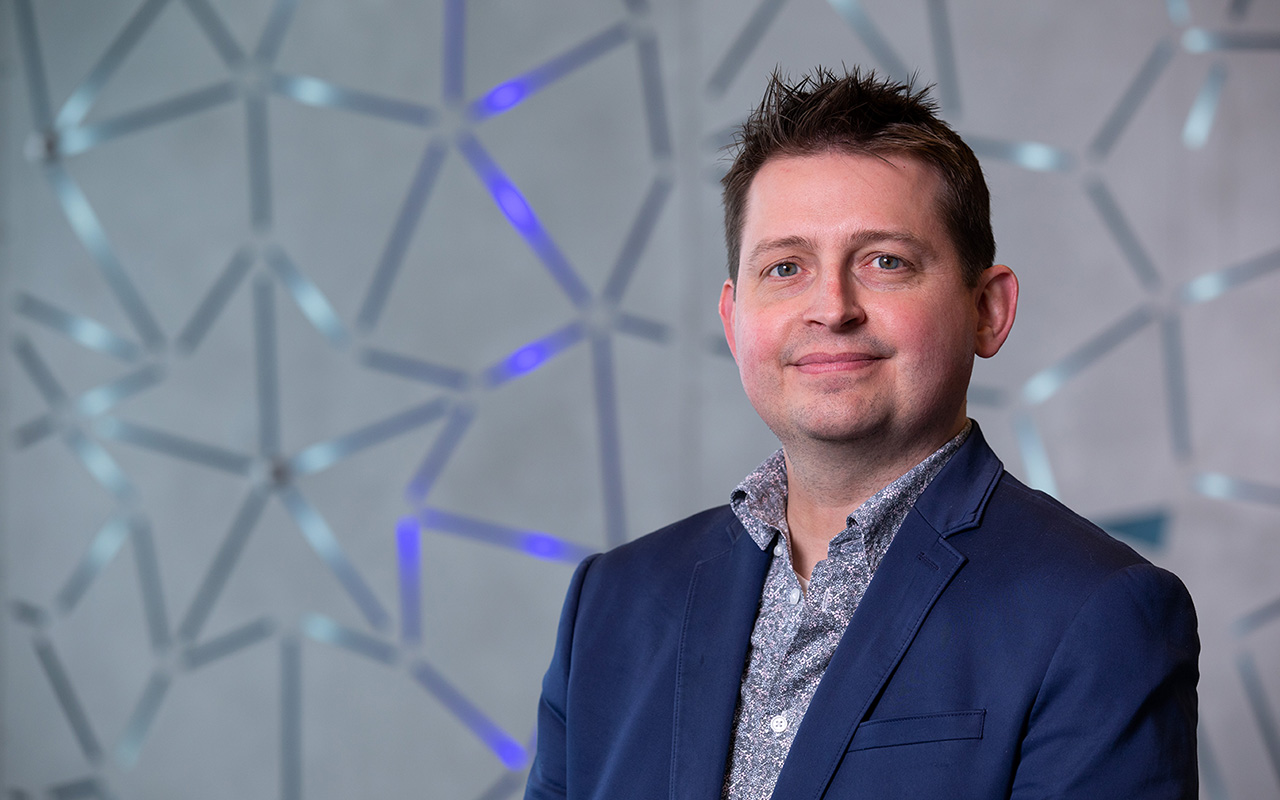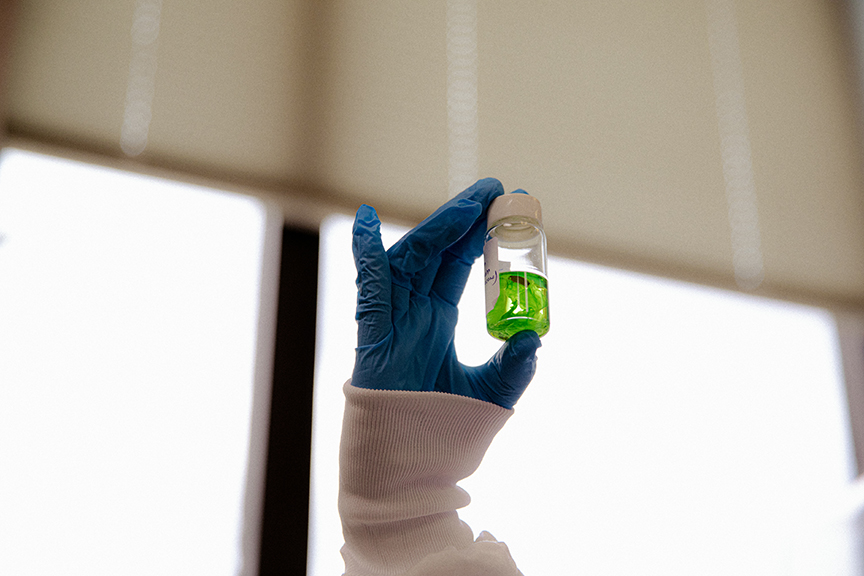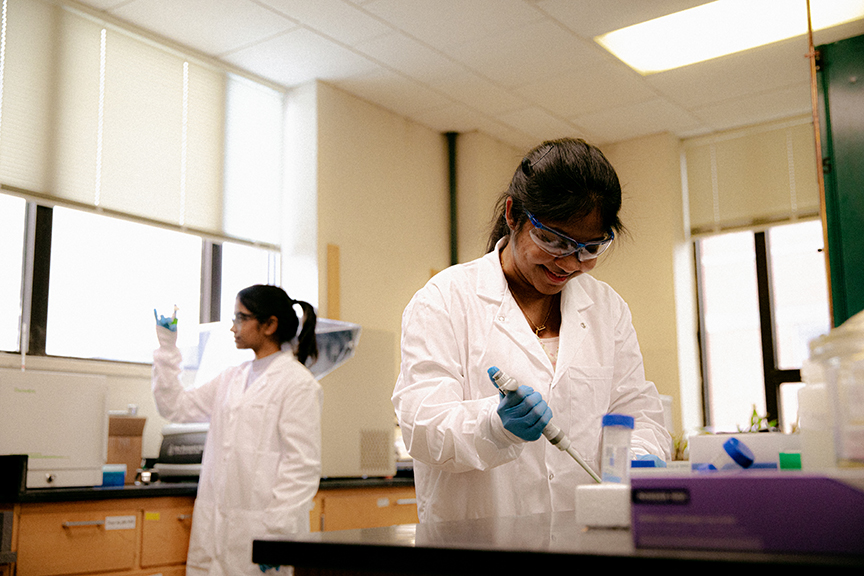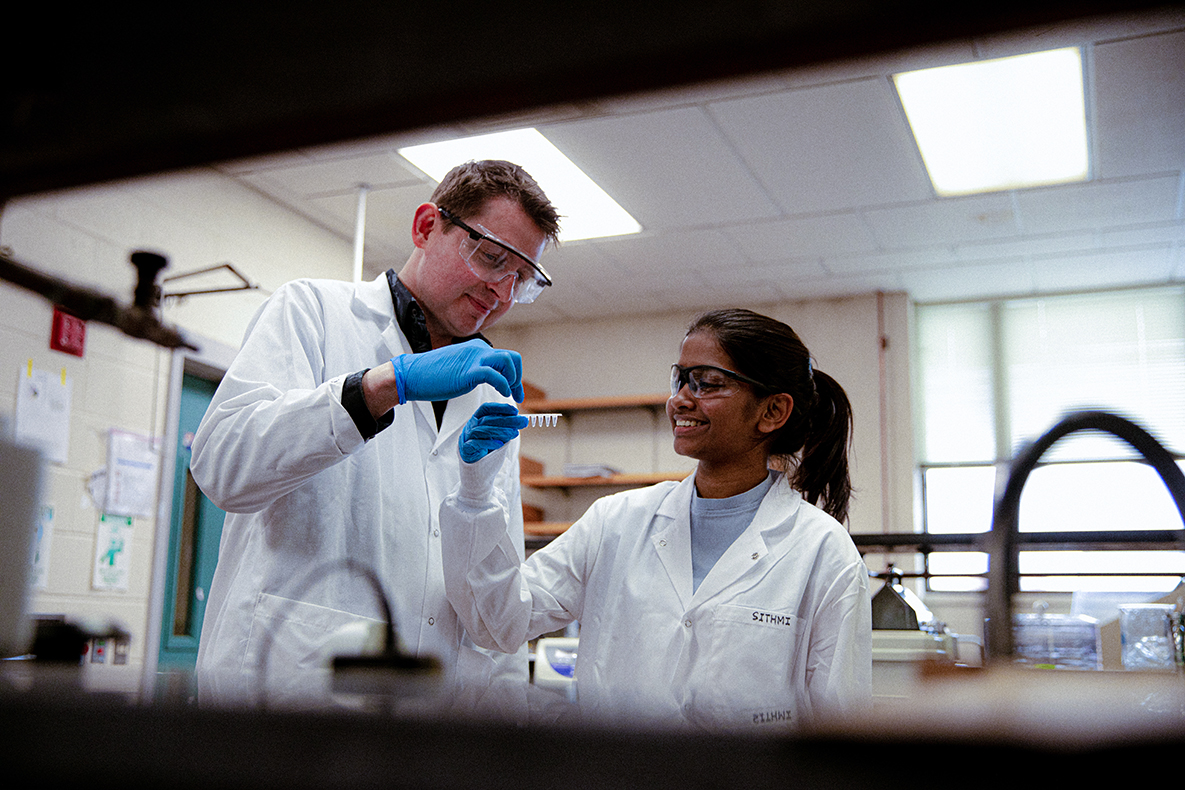If you see Jared Anderson at the grocery store buying fish, don’t assume that’s what he’s having for dinner.
There’s a good chance that salmon filet is destined for Anderson’s lab, a 3,000-square-foot space in Gilman hall, where a stunning range of groundbreaking research is underway. Whether developing patented methods to remove bacteria from food or improving the safety of pharmaceuticals, Anderson’s work is advancing human health. It is also providing incredible opportunities for graduate and undergraduate students.
Anderson is a rare breed. A professor of chemistry and inaugural holder of the Alice Hudson Professorship in Chemistry, he’s one of maybe 15 academic-based separation scientists in the United States. Nearly every top chemistry department with a strong analytical chemistry program in the country has one, and Anderson is Iowa State’s.
“Separation science is in the DNA of Iowa State. The work of professors Spedding and Wilhelm related to the Manhattan Project involved separation science,” said Anderson, who is also a joint faculty member at the U.S. Department of Energy’s Ames National Laboratory. “We have a long history of world-renowned faculty who were pioneers in this area.”
Separation scientists separate substances into individual components. It’s complex, sometimes messy work. Think Marvel Comics’ superhero Ant-Man in the multiverse. Once separation is achieved, pure molecules can be isolated for further research and study. The targeted molecules are often measured to determine their quantity or concentration levels within a substance. One aspect of Anderson’s work focuses on sample preparation, a process necessary to make separations happen.
The science is in high demand, particularly in the pharmaceutical, petrochemical, and food industries.
“Separation science is in the DNA of Iowa State."
“Virtually every sector of industry has to perform separations because products are made up of complicated mixtures,” he said. “The industry demand is so high that most separation scientists go that route instead of academia. That’s good for my graduate students, who always have multiple offers before they graduate. But the growing dearth of separation scientists in academia in the U.S. is concerning and I’m on several committees hoping to reverse this trend.”
Return to Iowa State
Anderson grew up in Sturgis, South Dakota, home of the legendary motorcycle rally which annually brings more than half a million people to the town of just over 7,000. But science, not cycles, was his passion.
“I always liked science and had good teachers. In high school, I took an organic and environmental chemistry class taught by Mrs. (Robin) Strain. She was a fantastic teacher who made it fun and invigorated my passion for chemistry,” he said. “I am a strong believer that teachers really make a difference, especially in the sciences and mathematics.”

Strain recommended that Anderson study chemistry at South Dakota State University, where he earned his undergraduate degree. For his Ph.D., he chose Iowa State. Anderson considered several distinguished schools, but they weren’t as friendly, or as humble.
“Iowa State was super-welcoming, which made a difference,” he said.
He joined the faculty at the University of Toledo in 2005 and stayed for 10 years before returning to Iowa State as faculty.
“I saw coming back to Iowa State as a tremendous opportunity,” he said. “It was a way to give back to the university and help strengthen the division of analytical chemistry.”
He’s making good on that goal. Widely published, his research has attracted millions in funding, and academic and industry partners from around the globe. He has nine patents and several pending, the majority earned during his tenure at Iowa State. He is a recipient of a National Science Foundation CAREER award, Emerging Leader in Chromatography Award, and the American Chemical Society Young Investigator in Separation Science Award. In 2014 and 2019, he was included in the “Top 40 under 40” and “Top 100 Analytical Scientists Worldwide” Power List, respectively, by The Analytical Scientist. In 2019, he was given the College of Liberal Arts and Sciences’ Dean’s Emerging Faculty Leader Award. Most recently, he was awarded the coveted Silver Jubilee Medal from the Chromatographic Society in the United Kingdom.
Coffee, drugs, blood, and fish
Separation chemistry often involves the use of solvents, such as ionic liquids (IL) or deep eutectic solvents (DES). These solvents are used in industry as catalysts and as separations media to do such things as remove caffeine from coffee or moisture from cereal.
Anderson and his research group collaborate with other Iowa State researchers to design solvents that undergo ordering at the nanoscale. This ordering of the solvent is thought to have an important effect in how they separate molecules, particularly in large-scale separations. The separation processes Anderson and his colleagues are developing through Ames Lab have the potential to be cheaper, quicker, and consume less energy.
Let’s start with coffee. Anderson and his team are working to isolate and separate the substance acrylamide, a natural byproduct that is chemically created when coffee beans are heated to high temperatures during the roasting process. Many studies have linked acrylamide to cancer in lab animals, and the Environmental Protection Agency classifies acrylamide as “likely to be carcinogenic in humans.” Anderson and his team have pioneered faster and more efficient ways to remove acrylamide from coffee.
His team is also investigating ionic liquids in pharmaceuticals, specifically analysis of genotoxic impurities and residual solvents. This involves the use of separation science to identify the levels at which these impurities exist and to ensure the problematic ones aren’t part of the product.

“Performing trace-level analysis of genotoxic impurities is a major analytical challenge in the pharmaceutical industry. They have to constantly evaluate new approaches to separate and quantify these molecules to show that these substances are at levels below the allowable daily intake for a particular pharmaceutical drug product,” he said.
Another project involves nucleic acid diagnostics to evaluate blood for cancer biomarkers.
“Cell-free nucleic acids are known to be produced from cancerous tumors, which release DNA into the bloodstream. They are at such small concentrations that finding them is more challenging than looking for a needle in a haystack,” he said. “My group is developing capture and analysis methods that can be turned into a clinical application, or something that you could do at a doctor’s office or at remote resource-limited settings for analysis.”
“Everything we do in my group will ultimately be used by other people – that’s the nature of separation science."
A similar project involves a process for detecting tuberculosis, which is a significant health concern in India and Africa. Anderson’s team, in conjunction with other researchers, is developing a separation method where bacteria associated with tuberculosis would be isolated in sputum samples. Sputum, like blood, is a complex substance with a lot of components. The ultimate goal is to enable analysis outside of a lab or medical facility, with an effective, easy-to-use device.
And as for that fish mentioned earlier – Anderson and his team actually do go to local stores to buy materials for testing, like fish. They will test fat in supermarket fish to measure levels of emerging contaminants, which are chemicals found in medicine, personal care products, and household cleaners. These chemicals enter water streams, regularly exposing fish to potentially toxic materials found in shampoo, soap, deodorant, and other products people use.
“Our process will measure emerging contaminants at extremely low, hard-to-detect levels,” Anderson said. “This could lead to a way to find and track where these containments are accumulating in the world.”
Lab of opportunity
Anderson readily credits his students with opening his eyes to the potential of newer technology. The team uses 3D printers to create equipment, like tiny test tubes for DNA storage, and is developing methods to use smartphones for diagnostics.
“Everything we do in my group will ultimately be used by other people – that’s the nature of separation science,” Anderson said. “With 3D printing, which has gotten so cheap, you can make a device and then just send the code to your collaborator, who can print it within hours. I’m lucky to have students who love working with this stuff.”
Anderson teaches undergraduate and graduate courses and recruits promising students for his research groups. He also chairs the department’s graduate student recruitment committee.

“Joining Dr. Anderson’s lab is one of the best decisions I made in my Ph.D. journey,” said Shashini De Silva, a third-year graduate research assistant in Anderson’s group. “In our lab, we are given the opportunity to learn many skills and get exposure to many different projects. He gives high priority to his students and encourages us to do even more when he realizes that we have more potential. He prepares his students very well for industry as well as academia. He has high expectations which is good because it pushes me more to do my best.”
Sithmi Hewage, a freshman chemistry major, joined Anderson’s group recently, performing nucleic acid analysis.
“I was fascinated by Dr. Anderson and his group’s work,” she said. “As I’m a freshman, I’m not familiar with hard-core chemistry research topics, but he explained all of his projects on a board, in a way that I can understand, and he invited me to attend his group meetings. Dr. Anderson has benefited me a lot as I’m learning new and interesting topics.”
Anderson is as big a fan of his students as they are of him.
“Innovation isn’t possible without the students who work in my group,” he said. “It’s exciting to see students get excited by their research as they see the human health and societal impact in what we do.”
